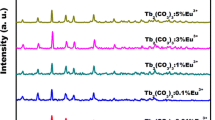Abstract
Y2O3 rods 100 to 200 nm in diameter and 10 to 20 μm in length are accessible via polyol-mediated synthesis of a precursor material with similar shape. By heating of Y(CH3COO)3 · xH2O and a defined amount of water at 190°C in diethylene glycol, the rod-like precursor material is formed. Infrared spectroscopy (IR), differential thermal analysis (DTA) and thermal gravimetry (TG) evidence that this precursor material still contains acetate. However, the precursor material can be transformed to Y2O3 by sintering at 600°C without destruction of the rod-like shape. According to X-ray powder diffraction analysis, the rods are well crystallized. They can be assumed to be with [100] orientation. By doping with Eu3+ (5 mol%), red emitting phosphor rods can be realized. With optical spectroscopy the typical line emission of Eu3+ is observed. Diffuse reflectance of Y2O3:Eu3+ rods is determined to be higher than 95% in the visible. While exciting at 254 nm (Hg-discharge), a quantum efficiency of 38.5% is proven for the prepared Y2O3:Eu3+ rods.
Similar content being viewed by others
References
C. N. R. Rao, B. C. Satishkumar, A. Govindaraj and M. Nath, Chem. Phys. Chem. 2 (2001) 78.
W. Tremel, Angew. Chem. Int. Ed. 38 (1999) 2315.
Y. Liu, C. Zheng, W. Wang, C. Yin and G. Wang, Adv. Mater. 13 (2001) 1883.
D. W. Wang, A. J. Millis and S. D. Sarma, Phys. Rev. Lett. 85 (2000) 4570.
M. Q. He, I. Minus, P. Z. Zhou and N. Mohammed, Appl. Phys. Lett. 77 (2000) 3731.
P. M. Ajayan and T. W. Ebbesen, Rep. Prog. Phys. 60 (1997) 1025.
J. T. Hu, T. W. Odom and C. M. Lieber, Acc. Chem. Res. 32 (1999) 435.
F. Krumeich, H. J. Muhr, M. Niederberger, F. Bieri, B. Schnyder and R. Nesper, J. Amer. Chem. Soc. 121 (1999) 8324.
S. A. Sapp, B. B. Lakshmi and C. R. Martin, Adv. Mater. 11 (1999) 402.
J. H. Fendler, “Nanostructures and Nanostructured Films” (Wiley-VCH, Weinheim, 1998).
D. M. Antonelli and J. Y. Ying, Angew. Chem. Int. Ed. 35 (1996) 426.
G. Buxbaum, “Industrial Inorganic Pigments” (VCH, Weinheim, 1993).
P. Toneguzzo, G. Viau, O. Acher, F. Guillet, E. Bruneton, F. Fievet-vincent and F. Fievet, J. Mater. Sci. 35 (2000) 3767.
C. Feldmann and H.-O. Jungk, Angew. Chem. Int. Ed. 40 (2001) 359.
C. Feldmann and C. Metzmacher, J. Mater. Chem. 11 (2001) 2603.
International Centre for Diffraction Data, Pennsylvania, Release 2001.
H. GÜnzler and H. BÖck, “IR-Spectroscopy” (VCH, Weinheim, 1983).
C. Feldmann, unpublished results.
G. Blasse and B. C. Grabmaier, “Luminescent Materials” (Springer, Berlin, 1994).
Author information
Authors and Affiliations
Corresponding author
Rights and permissions
About this article
Cite this article
Feldmann, C., Merikhi, J. Synthesis and characterization of rod-like Y2O3 and Y2O3:Eu3+ . Journal of Materials Science 38, 1731–1735 (2003). https://doi.org/10.1023/A:1023279710821
Issue Date:
DOI: https://doi.org/10.1023/A:1023279710821




